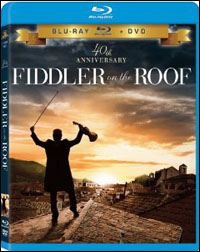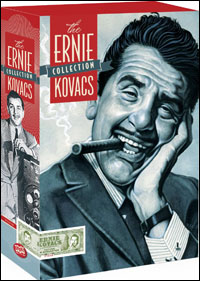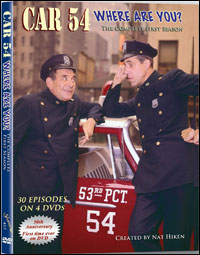*
Television adaptations of vintage Broadway musicals are prone to disappoint. They often sound intriguing, and sometimes offer an element or three that make them worth tracking down. But the restrictions of live television, the lack of rehearsal time, and the inevitable cutting of an hour or more's worth of musical too often take their toll. Which leads us to 1950s servings of Cole Porter's two greatest hits.
| |
 |
|
Start with the stars. Drake, at his best, was an actor of tremendous power; and here he is at his best. The actor was 34 when he starred in Kate on Broadway, and 44 at the time of the telecast. We know from the original Broadway cast album how good he was singing Porter's finest theatre score. Watching him in this Hallmark presentation, which aired on Nov. 20, 1958, we are struck not only by his singing but by his acting. He believes every word of it, down to every conceitedly obnoxious phrase. He also looks like he is gonna swallow the camera altogether. Drake positively sparkles; for once, a Broadway performance of the 1940s has been captured. Those of us who weren't born in time to see Drake in Kate or the 1953 Kismet can get a good idea of what he must have been like, back then, on stage.
If Drake is one of Broadway musical's most celebrated performers of his time, his co-star is the opposite. Prior to Kate, Patricia Morison had appeared in two unsuccessful musicals; the first earned her a contract at Paramount, where she didn't make much of a mark. The role of Lilli in Kate turned her into a Broadway star overnight. But that was to be it for Morison; whether from lack of opportunity or lack of desire, she never created another stage role. She did score a triumph in the 1951 London production of Kate, and was reportedly one of Broadway's best Annas ever as the final replacement in the original production of The King and I. But another musical, never. There's something to be said, though, for stopping at the top. Ms. Morrison is still around, apparently, at the age of 95. Here in the television Kate, Morison matches Drake every step of the way. She gives a clever and knowing performance, singing the daylights out of the score and hamming it up as she goes along. Just watch her smash the crockery in "I Hate Men"; aye, there's a wench! The chemistry between the two is impeccable; you can see in "Wunderbar" how much the actors enjoy each other while their characters warily eye the competition for vulnerability. Or perhaps, even, a rekindling of the romance suggested by Porter's potent but sarcastic Viennese waltz.
A third stage Kate veteran is Julie Wilson. Not the Julie Wilson we know, mind you; yes, this is the same Julie Wilson, but the grandly sophisticated cabaret artist of the recent past was — in her days playing the Kate ingenue Lois Lane — a Betty Huttonish hoyden. This takes a bit of getting used to, but by the time she reaches "Always True to You in My Fashion" we see what she is at, and it pays off. "Fashion" is done impeccably well; it's a battle of manners, of sincerity versus the raised eyebrow, and Wilson revels in it. No stranger to Kate, she played the role in the National Company and took her performance to London as well. Wilson returned to Broadway to replace Joan Diener in Kismet and Janis Paige in The Pajama Game, before revisiting Lois for the TV version.
The Bill Calhoun of the occasion is Bill Hayes, of Rodgers & Hammerstein's Me and Juliet (where he introduced "No Other Love"). He also had a No. 1 Billboard hit in 1955, "The Ballad of Davy Crockett." Hayes has little to do, here, though, as his big number — "Bianca" — is cut. Reducing the playing time from 150 minutes to 78 does have consequences, of course. Most of the dance — and Kate was a big dance show — is gone. Besides "Bianca," Fred loses his most beautiful ballad, the tempestuous "Were Thine That Special Face."
The other big loss is "Too Darn Hot." Lorenzo Fuller, who played Fred's dresser Paul — and is the only Broadway cast member besides Drake and Morison on the DVD — led the number onstage. Here, he is instead given "Another Op'nin', Another Show" (albeit in a truncated version). The Hattie of the occasion is not from the original cast of Kate; she is, however, a veteran of the original Porgy and Bess. Gershwin's 1935 opera featured the Eva Jessye Choir, and here on the Kiss Me, Kate video is Porgy's choral director Eva Jessye herself.
The cast is rounded out by the two Gangsters, as all productions of Kate must be. And they are a great pair, although considerably younger than what you usually get. Harvey Lembeck was already well-known, by virtue of his performances in Mister Roberts, Stalag 17, and TV's "Sergeant Bilko." His partner in crime is Jack Klugman, who was all but unknown at the time; he had only just made his first step to prominence, in the 1957 film version of "Twelve Angry Men." The TV Kiss Me, Kate was telecast in November 1958; Klugman then moved on to the role of Herbie in Gypsy, the following May. Jack isn't much of a singer, no, but he does a mean clog dance in "Brush Up Your Shakespeare."
Kate was directed for TV by George Schaefer, who specialized in theatre-on-TV. (Choreography was by Ernest Flatt, with Franz Allers conducting.) My guess, though, is that Drake, Morison and Wilson pretty much recreated their stage blocking. Especially during the songs; these performances are so rich and full — and so good — that they look like the result of hundreds of performances-worth of sharpening before appreciative audiences.
| |
 |
|
Hayward turned to Jule Styne, who had just then produced the successful Broadway revival of Rodgers and Hart's Pal Joey. Jule knew Ethel — he had served as her vocal coach in Hollywood days — and immediately went home and asked his housemate what he thought; his housemate being Frank Sinatra. Merman and Sinatra in Anything Goes? That sounded big, even if ol' blue eyes — or young blue eyes, at the time — was just coming out of a career slump.
Who to get for "Moonface Martin," the third of the trio of stars? Victor Moore, who originated the role, didn't have a bankable name to the TV public, and he was already 78; what's more, his presence would only serve to highlight the absence of original leading man William Gaxton. So Styne went to Merman's co-star from the 1939 Cole Porter hit DuBarry Was a Lady, Bert Lahr. Merman and Lahr together again made it inevitable that they reprise "Friendship," their hit duet from DuBarry. And if they were interpolating "Friendship" for Bert, why not "Just One of Those Things" and "You Do Something to Me" for Frank? I think you see where we are going, here. The Colgate Comedy Hour, the weekly series on which the show was telecast, ran 53 minutes. Taking out time for the "Ethel-in-her-dressing-room" introduction and the bows, this Anything Goes was over after only 47 minutes. As the show ended, the actors were clearly signaled that they were several minutes short — ah, live television! — so they stood there offering thank yous and eventually singing another reprise of the title song. (Sinatra gave up after the first phrase, saying "I wish I knew the words.")
So you have 47 minutes of Anything Goes, and you've added the three aforementioned song hits. And you gotta give Frank a chance to sing a tag of Ethel's song "I Get A Kick Out of You." ("You give me a boot," he sings.) And Ethel needs to sing a tag to Frank's "Just One of Those Things." Plus reprises of "Anything Goes" and "I Get a Kick Out of You." Does anyone have a stopwatch? How many Anything Goes songs? Five. The two mentioned above, "You're the Top" (in which Sinatra dances in such a manner that I suppose the boys at Jilly's would have thrown him on the street if they saw it), "All Through the Night," and "Blow, Gabriel, Blow." The plot? Missing in action, mostly. Moonface is there with Reno Sweeney, albeit in cut-down style, but Frank is Harry Dane, Ethel's agent and ex-lover. (Frank looks 15 years younger than Ethel. At least.) The fourth principal is Bonnie, Moonface's moll, played by Sheree North; she had attracted attention in Styne's 1953 musical Hazel Flagg, and was being groomed by 20th Century Fox to replace Marilyn Monroe. North slinks around a lot and does some dancing. Hope Harcourt, the romantic lead central to Anything Goes, is gone altogether.
So this is an extremely slender Anything Goes. It does give us Merman, doing some of her songs; it gives us Sinatra, looking uninterested and under-rehearsed; and it gives us Lahr, shortly before he turned to Beckett and the original Broadway production of Waiting for Godot.
| |
 |
|
The Blu-ray edition is newly remastered in high definition, with bonus items including a couple of features on director Jewison, as well as audio commentary by Jewison and Topol; a piece on John Williams, who won an Oscar for his musical adaptation; and a new-but-unused song for Perchik, "Any Day Now."
A fine film this is, and one which has had an enduring effect on audiences of all religions, races and outlooks. Can I help it if I've never been able to displace images of the stage version, which I saw when it was fresh and new, three months into the run? The magic of Fiddler, to me, is wedded to the magic of Robbins. I remember sitting there as Tevye and his family started to sing "Sabbath Prayer." Suddenly, Robbins revealed other family groups clustered around their own candles; not only on the sides of the Tevye's family but above and around them. They were positioned on scaffolding, behind the scrim, of course; but I didn't then know or care what he did, or how he did it. It simply seemed like magic, and quadrupled the effect (and the message) of the song. That is Fiddler to me; no widescreen, no vast vistas, just canvas and lights and wizardry.
*
| |
 |
|
Kovacs built his TV comedy on sketches; standard, extended or brief, he seemed to let content dictate form. Nothing was too much or too little, it was all in the payoff. Consider this one, chosen from my random sampling of the set: an industrialist stands in a boardroom, around a big conference table. On the wall is a photo of a public works dam (like the Hoover). After an establishing shot, he taps the photo with a pointer — and water gushes out, flooding the actors and the set. (While Kovacs was a pioneer in trick photography, everyone here gets unquestionably soaked.) The whole thing lasts 12 seconds; a lot of work and expense for one little joke. But what a gag! What a payoff! Here and elsewhere, Kovacs displays an incisive imagination similar to that of Buster Keaton; not as a performer, but as a visually stimulating and wildly subversive comic mastermind.
"Laugh-In," you say? "Saturday Night Live"? Johnny Carson's "Tonight Show"? Yes, all of them stem from the comedy of Ernie Kovacs. The material on these tapes is not all polished; some of the jokes are improvised, some of them don't work. But Kovacs makes for compelling viewing, and what a treat that we finally have a good chunk from the archives. And now, I'll go back and watch some more of The Nairobi Trio. Trust me, they are funny.
(A note for those interested in such things: that sultry actress in the final five ABC specials from 1961, billed as "Maggi Brown," turns out to be Margaret Styne. She was married to Jule from 1962 until his death in 1994, and continues to oversee the rights to his work today.)
*
| |
 |
|
Joe E. Ross and the pre-"Munster" Fred Gwynne starred as officers Gunther Toody (the short one) and Francis Muldoon (the tall, skinny one). They got into assorted scrapes, every week, for 60 episodes over two seasons. The show is especially noteworthy for its array of talents. Shooting in New York — at the old Biograph Studio in the Bronx, actually — Hiken filled the cast with local talent. I remember being stunned when I went to see a Wednesday matinee of Irma La Douce at the Alvin in November 1961, at the tender age of eight, and immediately picked out Officer Muldoon as Polyte-le Mou (the tall, skinny mec — or pimp, in the argot). "Car 54" had just gone on the air in September, and there was Gwynne playing a small role. Knowing David Merrick as I later did, I can only imagine that he refused to allow Gwynne to buy his way out of his contract, even though he was starring in a new sitcom.
But Gwynne wasn't the only one. Paul Reed, who played the long-suffering Captain Block, was simultaneously singing "A Secretary Is Not a Toy" in the spanking, new How to Succeed in Business without Really Trying. (A look at the episode list shows that Reed missed five early episodes, presumably shot during that show's tryout in Philadelphia.) Reed — real name, Sidney Kahn — was a wonderful foil, specializing in this sort of authority-figure-with-a-short-fuse role. He was a real musical comedy guy, creating Lt. Brannigan in Guys and Dolls; Charlie Cowell, the salesman out to nail Harold Hill in The Music Man; Mr. Bratt in How to Succeed; R.H. Macy in Here's Love; and Mr. Dobitch, that dirty old man in need of an apartment, in Promises, Promises.
Also concurrently on Broadway — at least for his first weeks on "Car 54" — was Al Lewis, just then playing Phil Silvers' henchman Moe Shtarker in Merrick's Do-Re-Mi. Lewis played Officer Leo Schnauser; he later joined Gwynne, of course, in "The Munsters." Standing out as Sylvia Schnauser was Charlotte Rae, but a glance at the extended cast list shows that Hiken grabbed all sorts of working New York actors. Guest stars across the first season include Wally Cox, Jan Murray, Molly Picon and Maureen Stapleton as a wayward gypsy.
As for that theme song — with a lyric by Hiken, to music by Rae's then-husband John Strauss — one of the calamities issuing over the call box was that Khrushchev was still at Idlewild, rhymed with "there's a scout troop short a child." (The Soviet premier had made a notorious trip to the U.N. in October 1960, on which occasion he famously pounded his shoe on a desk in protest.) I, in my pre-teen manner, always thought they should have changed the lyric to "there's a cat stuck up a tree, Khrushchev's still at Kennedy"; but by the time the airport was renamed, "Car 54" was no longer prowling the Bronx.
(Steven Suskin is author of the recently released Updated and Expanded Fourth Edition of "Show Tunes" as well as "The Sound of Broadway Music: A Book of Orchestrators and Orchestrations," "Second Act Trouble" and the "Opening Night on Broadway" books. He also pens Playbill.com's Book Shelf and On the Record columns. He can be reached at [email protected].)
*
Visit PlaybillStore.com to check out theatre-related DVDs for sale.










